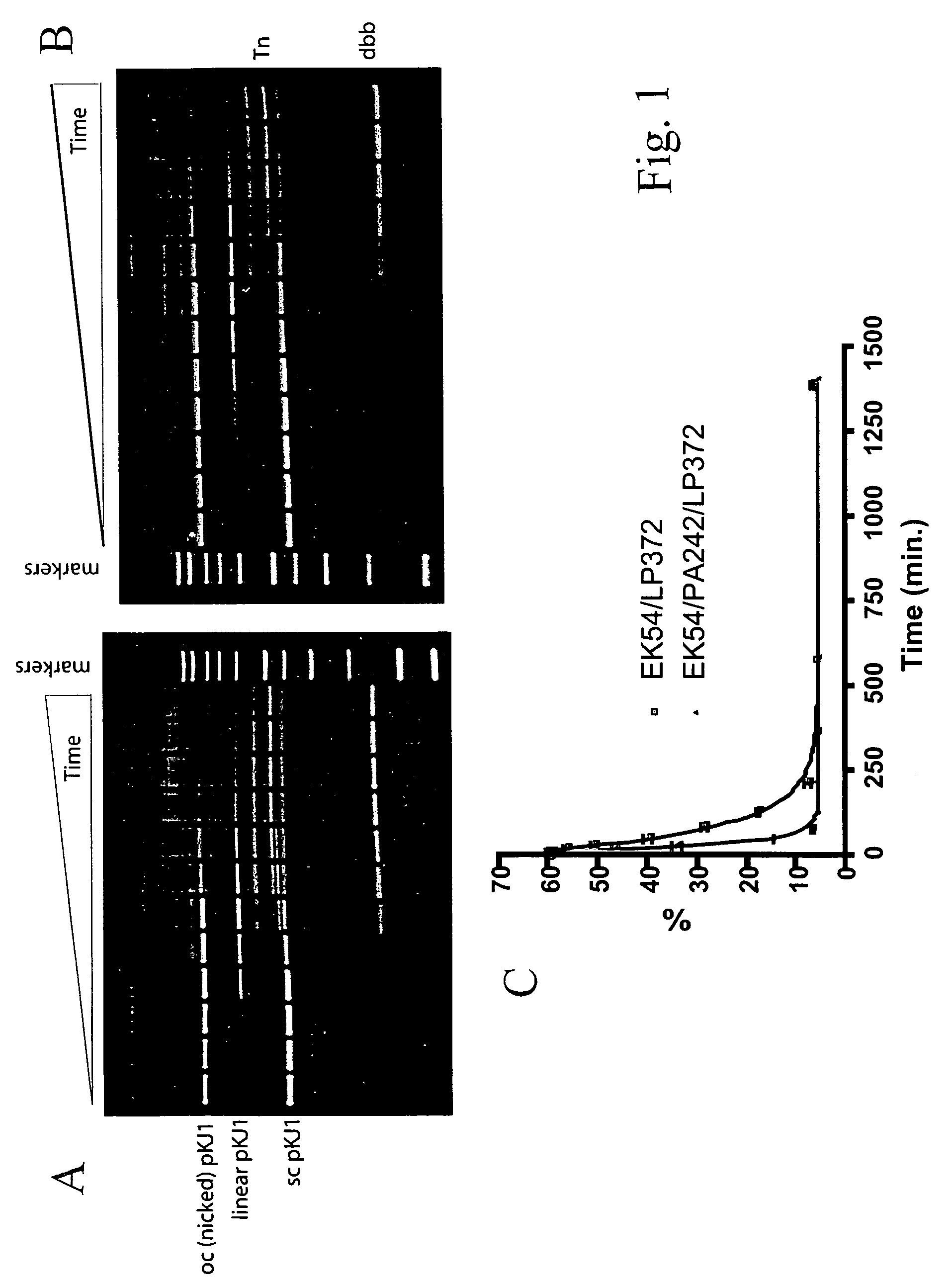Tn5 transposase mutants and the use thereof
a transposase and mutant technology, applied in the field of tn5 transposase mutants, can solve the problems of low mobility level, inhibit the ability of researchers to detail the molecular transposition process and exploit, and achieve the effect of greater avidity and higher transposase activity
- Summary
- Abstract
- Description
- Claims
- Application Information
AI Technical Summary
Benefits of technology
Problems solved by technology
Method used
Image
Examples
example 1
In Vivo Transposition with Tn5 Tnp Mutants
[0037]EK54 / LP372 / PA242 Tnp (proline to alanine mutation at position 242) and EK54 / LP372 / PG242 Tnp (proline to glycine mutation at position 242) were constructed by overlap PCR. Bases corresponding to aa 141-358 were amplified from pRZ10300 (Steiniger-White, M., and Reznikoff, W. S. “The C-terminal alpha helix of Tn5 transposase is required for synaptic complex formation,”J. Biol. Chem. 275: 23127–33 (2000), incorporated by reference in its entirety) using Pfu polymerase and internal mismatched primers containing the mutation. The external primers included Tnp NheI and NotI sites. PCR products were digested with NheI (New England Biolabs, Beverly, Mass.) and NotI (Promega, Madison, Wis.) and ligated to the large NotI-NheI fragment of both pRZPET2 (Goryshin and Reznikoff, 1998) and pGRTYB35 (Bhasin, A., Goryshin, I. Y., Steiniger-White, M., York, D., and Reznikoff, W. S. “Characterization of a Tn5 pre-cleavage synaptic complex,”J. Mol. Biol. 3...
example 2
In Vitro Transposition with Tn5 Tnp Mutants
[0039]Eight Tn5 Tnp mutants were constructed by the method described in Example 1: EK54 / LP372 / PA242, EK54 / LP372 / PG242, EK54 / LP372 / PV242, EK54 / LP372 / PL242, EK54 / LP372 / PI242, EK54 / LP372 / PY242, EK54 / LP372 / PF242, and EK54 / LP372 / PD242. These mutants and EK54 / LP372 Tnp were tested for in vitro transposition using two different substrates, pKJ1 and pKJ4. pKJ1 is a pUC19 vector with a 1,200 bp transposon (Tn) flanked by wild-type OEs (SEQ ID NO:3) while pKJ4 is isogenic to pKJ1 except that the Tn is flanked by modified OE sequence as defined by SEQ ID NO:5.
[0040]The in vitro transposition assay was performed as follows. 12 nM plasmid substrate (pKJ1 or pKJ4) was incubated with either 100 nM (for pKJ4) or 250 nM (for pKJ1) Tnp mutant in 100 mM potassium glutamate, 20 mM HEPES, pH 7.5, and 10 mM magnesium acetate at 37° C. 10 μL timepoints were taken at various intervals and added to 5 μL 1% SDS to stop the reaction. 5 μL of agarose gel loading dye w...
PUM
 Login to View More
Login to View More Abstract
Description
Claims
Application Information
 Login to View More
Login to View More - R&D
- Intellectual Property
- Life Sciences
- Materials
- Tech Scout
- Unparalleled Data Quality
- Higher Quality Content
- 60% Fewer Hallucinations
Browse by: Latest US Patents, China's latest patents, Technical Efficacy Thesaurus, Application Domain, Technology Topic, Popular Technical Reports.
© 2025 PatSnap. All rights reserved.Legal|Privacy policy|Modern Slavery Act Transparency Statement|Sitemap|About US| Contact US: help@patsnap.com

